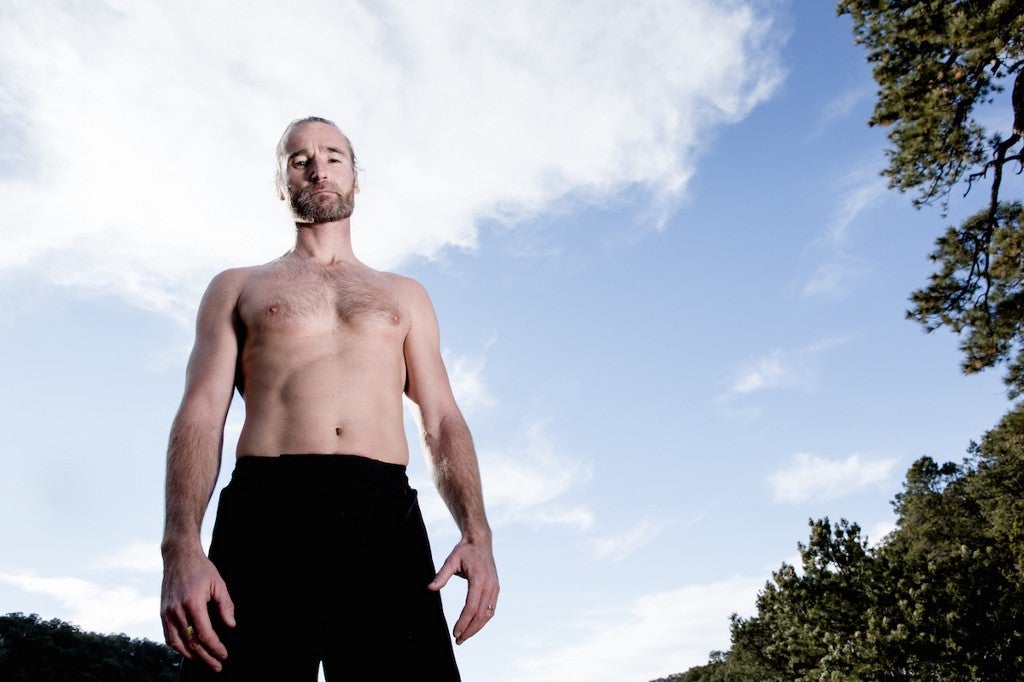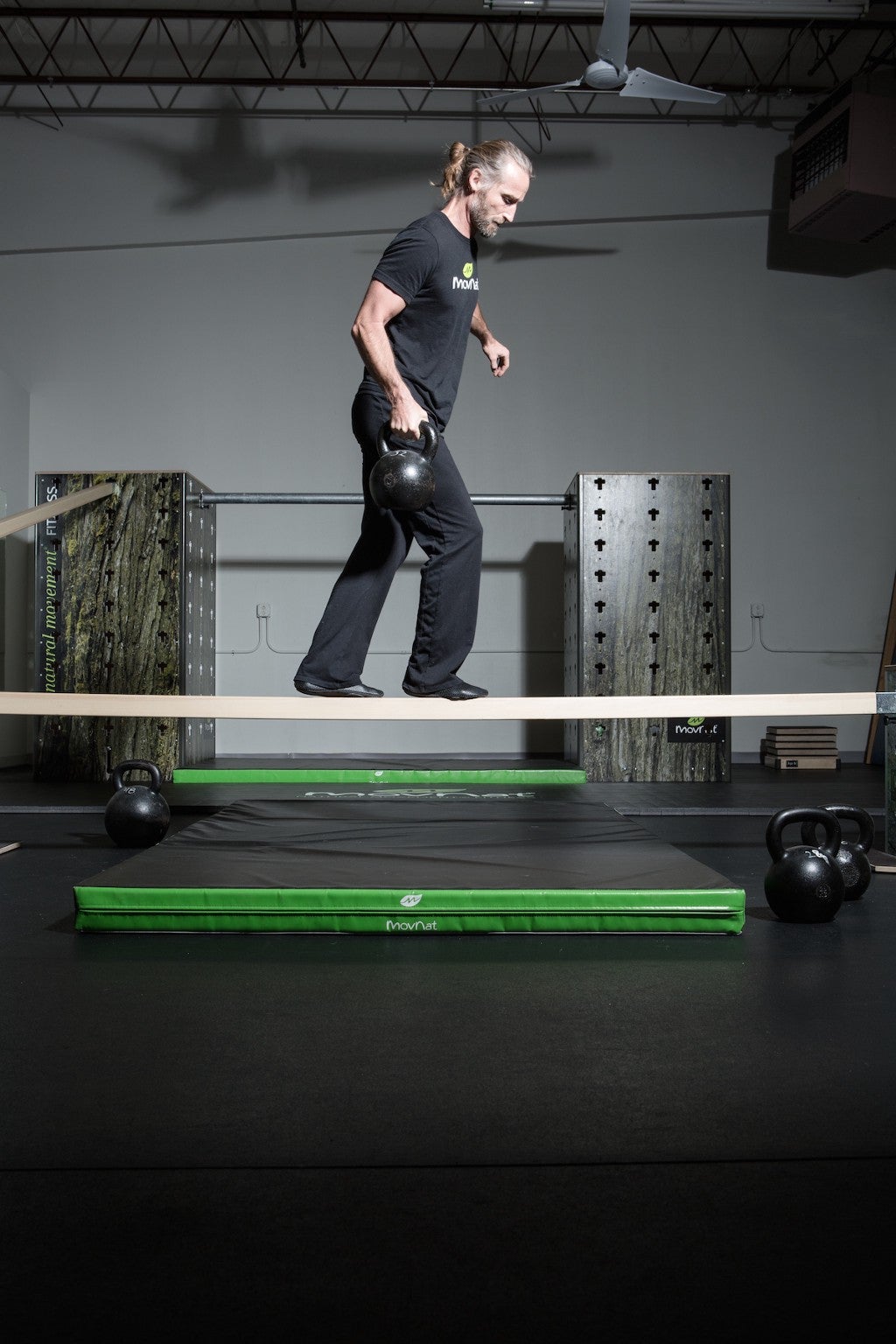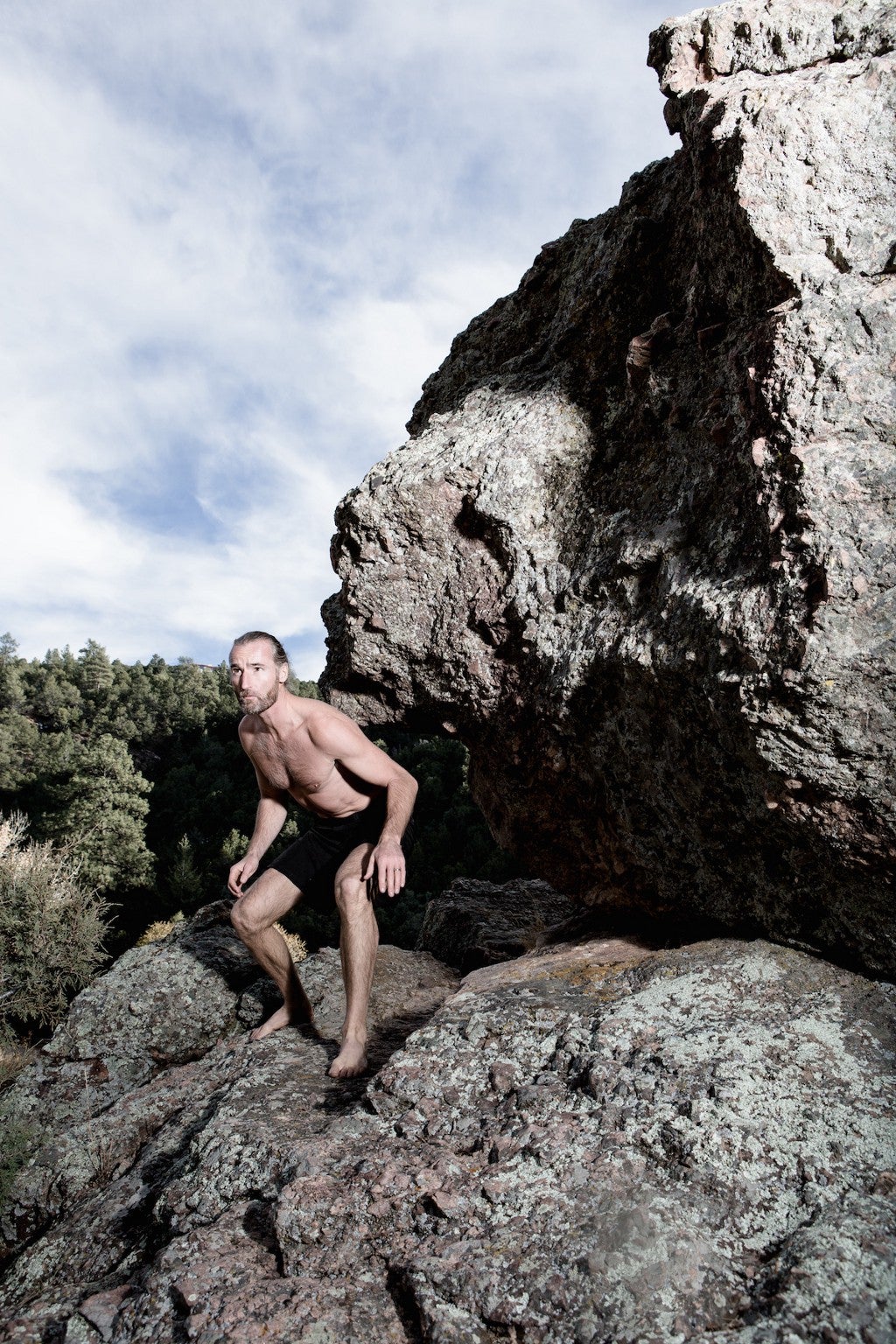Dressed in all black, Erwan Le Corre plants his hands and feet in the hot Santa Monica sand. He points his lithe torso at the cloudless summer sky and begins to model the crab walk, or as he calls it, “the inverted crawl.”
“I don’t like animal names,” Le Corre explains to the 20 men and women who have paid $480 each for 10 hours of Le Corre’s time, scuttling away from them toward the Pacific Ocean. “Crabs don’t have a monopoly on this movement.”
Le Corre is the creator of MovNat, a fitness philosophy that encourages people to rediscover movements early humans relied on to hunt, gather and survive in the wild — things such as jumping, crawling and climbing — and to ditch the machines and free weights of an Equinox. A workout consists of combining those movements into short, high-intensity interval circuits, and, if Le Corre’s physique is an advertisement of his product, the regimen seems to work.
At 43 years old, the French transplant to New Mexico is an image of paleo perfection, ripped but lean. He has a salt-and-pepper goatee and long, sandy hair tucked into a top knot. But as Le Corre would tell you himself, it’s not about what a body looks like; it’s what it can accomplish. In a 2008 video that introduced his brand of caveman calisthenics to the world (“The Workout the World Forgot”), he’s seen sprinting barefoot through the forest, pushing a tree trunk through a river, hurling a boulder and crawling through a cave (invertedly, of course).
“The bulk of the fitness industry is based on a fraud,” Le Corre tells me. “It’s based on the mental illness called ‘Body Dysmorphia Syndrome.’”
That video was filmed in the Corsican wilderness, but Santa Monica’s Muscle Beach — with its pull-up bars, balance beams and gymnastics rings — would have to do for an introductory workshop. I was intrigued by what I’d seen and read about this contrarian Frenchman who diagnoses the ails of modern society as “human zoo syndrome” and has become a cult fitness icon for a cultural moment obsessed with romanticizing the “way we’re evolved to live.” MovNat deconstructs and repackages bits of a number of de rigeur health and fitness trends — barefoot running, Crossfit, functional fitness, primal fitness, parkour and all things paleo — within an anti-industrial ideological brand. It seemed as if Le Corre was attempting to subvert the superficiality of fitness by making it more radical, which could be either exciting (think gym rats who care about the earth) or utterly terrifying (think gym rats who think they’re changing the world by working out). But the fitness world is always looking for the next big thing, and I wondered if MovNat could be it.
As I made my way to the designated MovNat meetup spot, I expected to be overwhelmed by a crowd of bodies chiseled to perfection. Instead I find a mix of parents with back pain, fitness instructors looking to bring a new trend to their gyms or personal training practice and survivalists eager to train for the demands of “real life.”
“The bulk of the fitness industry is based on a fraud,” Le Corre tells me. “It’s based on the mental illness called ‘Body Dysmorphia Syndrome.’” Today he’s bringing the antidote to the six-pack worshipping beaches of Southern California. It was here that in the 1930s America’s fitness revolution began. Bodybuilding legends like Jack LaLanne came here to pump iron. Just blocks away, fitness entrepreneur Vic Tanny opened a health club in 1939 that would become the national model for the modern gym chain. Le Corre detests the legacy of that fitness culture, which focused on isolating muscles to get “swole,” and he blames it for causing people to fundamentally misunderstand what it means to be fit.
“Everybody says, ‘I’m in shape, or I’m out of shape,’” he tells his students, many of whom have flown in from out of state for this rare, in-person appearance by Le Corre. “Everybody’s in shape. You’ve been shaped,” he says, curving his back to model the slumpy posture of the average office worker. “That’s your shape.” While the comforts of modern society have made the need to move irrelevant, Le Corre assures these students assembled on the beach — and a growing global brigade of followers — that natural movement will lead them toward not just better fitness but a whole new orientation with the world.
“Be strong to be free, people,” Le Corre encourages, as we begin to practice our own inverted crawls. “Don’t be strong to be a cog in the machine.”
MovNat’s origins lie not in some cavern or desert but in the most cosmopolitan of global capitals: Paris. It was there Le Corre spent his twenties training with legendary stuntman Jean Haberey, whose dedicated crew of followers would join him in late-night adventures throughout the 1990s. “We would climb on top of bridges and jump into the river at night in the winter with no wetsuits,” Le Corre remembers. “We would climb scaffoldings in the city and balance on top of them in the wind. Movements that if you missed, you basically can die.”
Le Corre survived, but he grew tired of following Haberey, whose group started to feel more and more culty. “I started to question both his true motives and also his ability to achieve anything, i.e., actually positively impacting people’s lives.” At the same time, the parkour trend (which his group was loosely connected with) began to go mainstream, transforming it into a competitive sport. Le Corre saw this as counterproductive to the radical spirit that inspired the movement. “If parkour becomes a sport, it will be hard to seriously teach and spread parkour as a noncompetitive activity,” he wrote on a message board in 2007. “And a new sport will be spread that may be called parkour, but that won’t hold its philosophical essence anymore.”

As such, he looked for something new, but was as dissatisfied with specialized forms of exercise like rock-climbing, running and Jiujitsu as he was with Haberey’s brand of parkour-like stunts. In 2004, he found something old: a 1912 training guide published by Georges Herbet, an officer in the French Navy who had systemized a fitness regimen based on practical movements (including swimming, climbing, and balancing). “Be strong to be useful,” was the central theory of Herbet’s Methode Naturelle, inspired by his experience helping rescue 700 people during a volcanic eruption in Martinique. “At first I thought, ‘I need to revise this method,’” Le Corre says. “Soon after, however, I realized, ‘No, I need to create my own method.’”
Four years later, Le Corre headed to Brazil to immerse himself in his training. There, he drew the attention of a group of Jiujitsu fighters in the beach town of Itacare who were curious about the ripped Frenchman who spent his days climbing trees and cliff diving. They asked him if they could train, too. “There was nothing formal,” Le Corre says. “No promotion, no company, no name. And I trained them for free.”
“Everybody’s in shape. You’ve been shaped,” Le Corre says, curving his back to model the slumpy posture of the average office worker. “That’s your shape.”
But as the video of his stripped-down, rugged workouts in Corsica began to circulate online, Le Corre drew the attention of fitness influencers, including former Men’s Health editor Christopher MacDougal, who reached out about a story. “I told him, ‘No, sir,’” Le Corre says. “‘Because what I do, and what I’m trying to do, is light-years away from the kind of magazine you work for and what it’s about: muscle isolation, exercise machines and supplements.’” But a year later, Le Corre relented and MacDougal came down to Brazil to train with LeCorre and write a lengthy feature on MovNat, giving sudden, mass exposure to a fitness technique practiced by just a handful of men.
“A lot of men were interested because the moves that I do are the pure expression of manliness,” Le Corre says. “All of a sudden, it wasn’t about what fitness should look like, but what fitness should be like. That fitness should have you do more than the results of what you look like in the mirror. It’s an important shift.” Although it probably didn’t hurt that the regimen created its own kind of physical ideal — lean, but strong enough to carry a tree.
Le Corre is hardly the first person to talk about switching from aesthetic fitness to functional fitness. He’s on trend with the most popular (and controversial) exercise movement to emerge this century: CrossFit. With 12,000 affiliates founded in just 15 years, the world’s largest gym brand explicitly bans mirrors from its bare-bones “boxes,” remixes old-school techniques from gymnastics and Olympic-style weightlifting, and has a founder who compares deadlifting to picking a pen off the ground. Le Corre readily explains what distinguishes MovNat from Crossfit. “In CrossFit you never balance on anything, but they claim it will improve your balance,” Le Corre tells me. “I claim that if you do not do balancing movements, you will not have improvement of your balance. That’s the difference.”
What’s less different is the business model. MovNat recently began to license gyms to offer its classes (for $199 per month) or rebrand with MovNat in their name (for $299 per month). But there haven’t been many takers so far. Just 12 affiliates are listed on MovNat’s website, and several of those are informal meet-up groups in parks. It seems like most of Le Corre’s money is made from workshops like these (where he picked up nearly $10,000 for a day’s work, with minimal overhead) and certifying teachers. So far, about 2,000 trainers, everywhere from Boise to Bratislava, have paid MovNat about $1,300 to learn to teach Le Corre’s techniques. Greg Ripley was one of the first to sign up in 2012, and led a MovNat meetup in a Minneapolis park for about a year, which attracted 20 participants at its peak. “It’s all kind of primed to launch a little more widespread at this point,” Ripley says, pointing to MovNat’s decision this summer to begin selling modular equipment to aspiring affiliates.
With names like The Grove ($8,000) and The Rainforest ($27,500), the equipment systems are designed to bring the experience of balancing on branches and jumping over rivers indoors via plyo boxes, beams and poles. That might seem paradoxical to Le Corre’s whole mission, but he explains it’s part of his plan to turn MovNat into the “prevailing approach to fitness” by 2019. (Mass production always requires some sacrifice of ideological purity.) Le Corre views the exercise systems as a useful way to introduce people to reconnecting with the outdoors, like training wheels. As he puts it, “This MovNat method is there to enable anybody — especially people who are out of shape — to get back to their natural movements, to get back to their baseline level of physical competency. And then ultimately to spend more time in nature.”
A Le Corre disciple from Orange County tells me he thinks we need to start learning MovNat in order to get by in a future defined by famine, conflict and environmental devastation.
This preoccupation with a movement’s practicality in “nature” was the hardest part of the workshop for me to take seriously. A lesson on jumping was related to the hypothetical activity of picking a coconut from a palm tree. Crawling while facing the opposite direction could be useful for, say, keeping one’s eyes on a predator while fleeing. But there seemed to be a disconnect between the urban lifestyles of workshop attendees like myself and the promise of useful and practical movements for an idealized caveman lifestyle. I joked to one participant that, perhaps, it’d be more useful to practice climbing for the event of breaking into your apartment while locked out or jumping to vault over a subway turnstile.
Whereas some people approach fitness to get better at a sport and others simply want to look and feel good, Le Corre describes his workouts as practice for the art of living — or more specifically, the art of avoiding death. “No one ever has to do ping-pong for their life,” he says to a quiet laugh from the workshop attendees. “No one ever has to stand on one leg and say ‘Om’ for their life.”

For some, that survivalist ideology is part of the MovNat appeal. An attendee from Orange County tells me he thinks we need to start learning MovNat in order to get by in a future defined by famine, conflict and environmental devastation. Another asks me to describe how I think this workshop has changed my life philosophy, after just 90 minutes in the sand. He looks stunned when I say it’s too soon to tell, but he finds solace in the stories of Le Corre’s assistant Kellen Millad, whose bulging pecs are evidence enough of how MovNat might improve one’s physicality, and who was more than happy to talk about how MovNat has altered his spirituality as well. Until he found MovNat, Millad recounts on his website, “I was addicted to working out, a slave to my diet and still plagued by my insecurities. I had the appearance of health, but was way out of balance.”
I imagine that as MovNat spreads, it will be called culty, like Bikram yoga, CrossFit and other fitness trends before it, which is likely a mixed blessing. The creators of Bikram and CrossFit have made millions by getting some people hooked, but others can be turned off by the obsessive attitude of practitioners. “More than just a gym, we are a community,” declares the website of the CrossFit gym I attended, which offers events like potlucks and rock climbing trips that I’ll probably never participate in. MovNat seems to take that motto one step further: more than a community, it’s a life philosophy.
“We are not meant to live in a confined environment,” Le Corre writes on his website. “We are not meant to be disconnected from the natural world and our own true nature.” Over social media, Le Corre juxtaposes photos of dying polar bears and melting ice caps with images of the simple-but-good life on his family’s property outside of Santa Fe. His kids wander the woods barefoot and eat lunch on top of a rock. They look like miniature, angelic cavemen-in-training.
“Yes, there are always people who just don’t care about anything real,” he tells me, when I ask if the “real movement” gimmick is necessary for people who maybe just want a workout. “Fake boobs, fake muscles, fake teeth, fake hair, luxury brands, Rolex, fake personality. Those people will want fake aspects of fitness. But a lot of people are seeking meaning.” He continues, “I do believe in that because everybody wants to be useful. No one wants to feel useless. And the truth is that when you can’t move your body, you are useless. Not only can you not help anybody, you need other people to help you.”
As Le Corre concludes the class with a session on MovNat’s take on weightlifting, tourists begin to stop, stare and film our group. This probably has something to do with the fact that, in lieu of barbells or other unnatural gym equipment, we are using “real objects” to practice what it’d be like lifting boulders, or tree branches, or freshly hunted zebra carcasses. Since none of these things are available on the beach, we are told to push-press our Nikes and plastic water bottles above our heads and deadlift our backpacks. This is not the intense workout I was prepared for. The most challenging part of the eight-hour workshop has been tolerating the nonstop, sweltering sun and the subtly technical climbing moves practiced on pull-up bars.
As I pause from my shoe-lifts to snap some photos, I wonder if this is how all fitness trends start: A bunch of dedicated weirdos making a scene at Muscle Beach, under the watchful gaze of a charismatic guru, who smiles as he sees his acolytes bring his movements to life, and kindly answers the questions from curious passersby who want to know more.
Le Corre leaves us with some parting words. “Don’t waste your time with stupid people that just want attention from you,” he says. “Go see a real shaman. There are too many showmen and not enough shamen.” Le Corre would seem to indicate he belongs in the latter camp, but on this stretch of beach — which has hosted gymnasts, yogis, body-builders, a devil-stick twirler, Naval trainees and capoeira fighters in the last few hours alone — we have somehow managed to put on a better show than all the rest.

